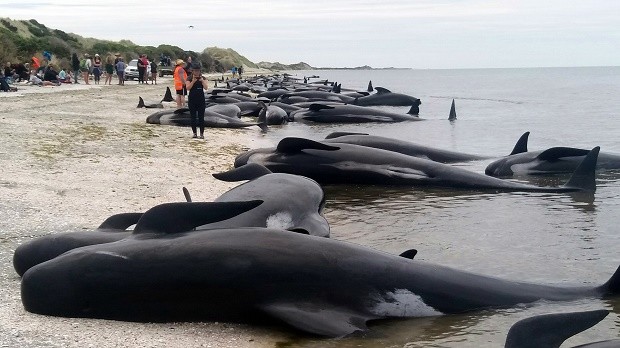New Zealanders refloat 100 pilot whales after 400 stranded

Whales are stranded at Farewell Spit near Nelson, New Zealand Friday, Feb. 10, 2017. New Zealand volunteers formed a human chain in the water at a remote beach on Friday as they tried to save about 100 whales after more than 400 of the creatures beached themselves in one of the worst whale strandings in the nation’s history. About three-quarters of the pilot whales were already dead when they were found Friday morning at Farewell Spit at the tip of the South Island. AP
WELLINGTON, New Zealand — Volunteers in New Zealand managed to refloat about 100 surviving pilot whales on Saturday and are hoping they will swim back out to sea after more than 400 of the creatures swam aground at a remote beach.
Department of Conservation Golden Bay Operations Manager Andrew Lamason said about 300 whales died but others are swimming in the bay near the beach and have joined up with a new pod of pilot whales.
The 416 stranded whales, most of them already dead, were discovered early Friday on Farewell Spit at the tip of the South Island.
READ: Hundreds of whales wash up dead on New Zealand beach
Rescuers managed to refloat several dozen whales on Friday but many beached themselves again overnight. Saturday’s rescue efforts during the morning high tide appeared more promising.
“Fingers crossed, the new whales are going to lead them out into deeper water,” Lamason said. “There’s a chance some might come back onto the beach.”
Article continues after this advertisementLamason said improved weather and crystal clear water helped with the latest rescue attempt. He said all the surviving whales were refloated, and about 100 volunteers formed a human chain in the water to prevent them from beaching again.
Article continues after this advertisementHe said volunteers were warned about the possibility of stingrays and sharks, after one of the dead whales appeared to have bite marks consistent with a shark. He said there had been no shark sightings.
With the rescue effort now paused, officials are beginning to turn their attention to the grim task of disposing of hundreds of carcasses.
Lamason said one option was to tether the carcasses to stakes or a boat in the shallow tidal waters and let them decompose. The problem with towing them out to sea or leaving them was that they could become gaseous and buoyant, and end up causing problems by floating into populated bays.
Farewell Spit, a sliver of sand that arches like a hook into the Tasman Sea, has been the site of previous mass strandings. Sometimes described as a whale trap, the spit’s long coastline and gently sloping beaches seem to make it difficult for whales to navigate away from once they get close.
There are different theories as to why whales strand themselves, from chasing prey too far inshore to trying to protect a sick member of the group or escaping a predator.
New Zealand has one of the highest rates of whale strandings in the world, and Friday’s event is the nation’s third-biggest in recorded history. The largest was in 1918, when about 1,000 pilot whales came ashore on the Chatham Islands. In 1985, about 450 whales stranded in Auckland.
Pilot whales grow to about 7.5 meters (25 feet) and are common around New Zealand’s waters.